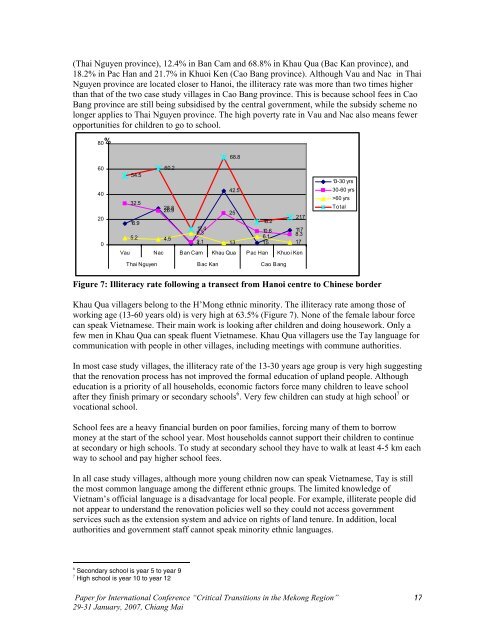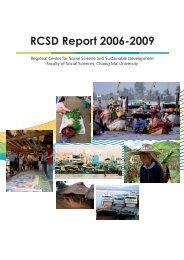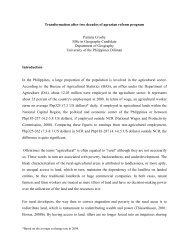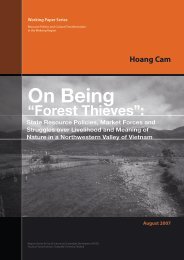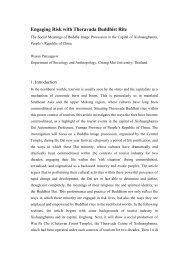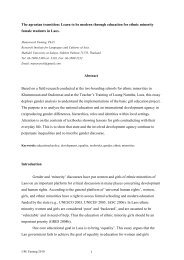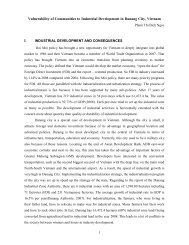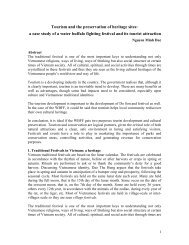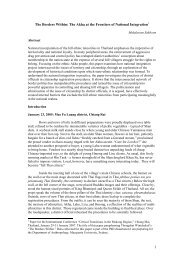Table 10: Number <str<strong>on</strong>g>of</str<strong>on</strong>g> people visiting <str<strong>on</strong>g>the</str<strong>on</strong>g> forest for collecting products in <str<strong>on</strong>g>the</str<strong>on</strong>g>ir free timeVillageTimber harvesting N<strong>on</strong>-timber product collecti<strong>on</strong>Male Female Male FemaleVau 19/24* 0/24* 9/24 24/24Nac 26/40 2/40 19/40 40/40Ban Cam 10/22 0/22 13/22 15/22Khau Qua 17/17 0/17 10/17 15/17Pac Han 18/18 0/18 10/18 14/18Khuoi Ken 15/15 0/15 13/15 15/15Total 105/136 2/136 74/136 123/136NB. * is <str<strong>on</strong>g>the</str<strong>on</strong>g> number <str<strong>on</strong>g>of</str<strong>on</strong>g> male and female interviewed in each village.In Pac Han, most working age males are engaged in illegal logging after <str<strong>on</strong>g>the</str<strong>on</strong>g> harvest. However,many <str<strong>on</strong>g>of</str<strong>on</strong>g> <str<strong>on</strong>g>the</str<strong>on</strong>g>m also go to <str<strong>on</strong>g>the</str<strong>on</strong>g> forest during <str<strong>on</strong>g>the</str<strong>on</strong>g> planting and harvesting seas<strong>on</strong>s to cut trees for saleto earn m<strong>on</strong>ey to buy food. In o<str<strong>on</strong>g>the</str<strong>on</strong>g>r case study areas like Vau, Nac and Khuoi Ken, a smallnumber <str<strong>on</strong>g>of</str<strong>on</strong>g> villagers regularly go to <str<strong>on</strong>g>the</str<strong>on</strong>g> forest for harvesting because timber or n<strong>on</strong>-timber forestproducts are scare.<str<strong>on</strong>g>The</str<strong>on</strong>g> reforestati<strong>on</strong> programs/projects create employment for local people but <strong>on</strong>ly a small number<str<strong>on</strong>g>of</str<strong>on</strong>g> jobs are available. In additi<strong>on</strong>, payment for work in <str<strong>on</strong>g>the</str<strong>on</strong>g>se projects is very low. For example,villagers receive <strong>on</strong>ly 50,000 VND (3.2 USD) per ha per year for forest protecti<strong>on</strong> andmaintenance work.In summary, employment and cash flow have become key factors affecting livelihoods since <str<strong>on</strong>g>the</str<strong>on</strong>g>‘Doi Moi’ process began. To reduce <str<strong>on</strong>g>the</str<strong>on</strong>g> pressure <strong>on</strong> natural resources, employment and cash flowmust be adequate and relatively stable. At present, however, employment and cash flow are notstable in most <str<strong>on</strong>g>of</str<strong>on</strong>g> <str<strong>on</strong>g>the</str<strong>on</strong>g> case study areas.3.5 Welfare and services3.5.1 Educati<strong>on</strong><str<strong>on</strong>g>The</str<strong>on</strong>g> educati<strong>on</strong> system in <str<strong>on</strong>g>the</str<strong>on</strong>g> six case studies is generally not well developed. Few <str<strong>on</strong>g>of</str<strong>on</strong>g> <str<strong>on</strong>g>the</str<strong>on</strong>g> casestudy areas have a primary school within <str<strong>on</strong>g>the</str<strong>on</strong>g> village. Sec<strong>on</strong>dary or high schools are <strong>on</strong>ly availableat <str<strong>on</strong>g>the</str<strong>on</strong>g> commune or district level. Village children from <str<strong>on</strong>g>the</str<strong>on</strong>g> case study area have to walk 3-12 kmeach way to a nearby commune to attend sec<strong>on</strong>dary school. High schools are available within <str<strong>on</strong>g>the</str<strong>on</strong>g>district centre <strong>on</strong>ly and children from <str<strong>on</strong>g>the</str<strong>on</strong>g> case study village have to stay in <str<strong>on</strong>g>the</str<strong>on</strong>g> distric<str<strong>on</strong>g>the</str<strong>on</strong>g>adquarters during school terms.According to three provincial governments, 100% <str<strong>on</strong>g>of</str<strong>on</strong>g> communes in <str<strong>on</strong>g>the</str<strong>on</strong>g>se provinces hadcompleted <str<strong>on</strong>g>the</str<strong>on</strong>g> program <strong>on</strong> eradicati<strong>on</strong> <str<strong>on</strong>g>of</str<strong>on</strong>g> illiteracy and <str<strong>on</strong>g>the</str<strong>on</strong>g> primary educati<strong>on</strong> compulsoryprogram in 2004 5 (Statistic Office <str<strong>on</strong>g>of</str<strong>on</strong>g> Thai Nguyen, 2004; Statistic <str<strong>on</strong>g>of</str<strong>on</strong>g> Bac Kan, 2004; Statistic <str<strong>on</strong>g>of</str<strong>on</strong>g>Cao Bang, 2003). This means that, <str<strong>on</strong>g>of</str<strong>on</strong>g>ficially, every<strong>on</strong>e who lives in <str<strong>on</strong>g>the</str<strong>on</strong>g>se provinces can read andwrite in <str<strong>on</strong>g>the</str<strong>on</strong>g> <str<strong>on</strong>g>of</str<strong>on</strong>g>ficial Vietnamese language. However, <str<strong>on</strong>g>the</str<strong>on</strong>g> surveys showed that many uplandinhabitants in all <str<strong>on</strong>g>the</str<strong>on</strong>g> case study areas could not read, write or even speak Vietnamese (see Figure7).Data from <str<strong>on</strong>g>the</str<strong>on</strong>g> field surveys and 136 sample household interviews in <str<strong>on</strong>g>the</str<strong>on</strong>g> six case villages reveal ahigh percentage <str<strong>on</strong>g>of</str<strong>on</strong>g> illiteracy (Figure 7). <str<strong>on</strong>g>The</str<strong>on</strong>g> illiteracy rate is 54.5% in Vau and 60.2% in Nac5 <str<strong>on</strong>g>The</str<strong>on</strong>g> eradicati<strong>on</strong> <str<strong>on</strong>g>of</str<strong>on</strong>g> illiteracy and primary educati<strong>on</strong> compulsory program is a nati<strong>on</strong>al programwhich was implemented from 2000 to 2004.Paper for Internati<strong>on</strong>al C<strong>on</strong>ference “Critical Transiti<strong>on</strong>s in <str<strong>on</strong>g>the</str<strong>on</strong>g> Mek<strong>on</strong>g Regi<strong>on</strong>”29-31 January, 2007, Chiang Mai16
(Thai Nguyen province), 12.4% in Ban Cam and 68.8% in Khau Qua (Bac Kan province), and18.2% in Pac Han and 21.7% in Khuoi Ken (Cao Bang province). Although Vau and Nac in ThaiNguyen province are located closer to Hanoi, <str<strong>on</strong>g>the</str<strong>on</strong>g> illiteracy rate was more than two times higherthan that <str<strong>on</strong>g>of</str<strong>on</strong>g> <str<strong>on</strong>g>the</str<strong>on</strong>g> two case study villages in Cao Bang province. This is because school fees in CaoBang province are still being subsidised by <str<strong>on</strong>g>the</str<strong>on</strong>g> central government, while <str<strong>on</strong>g>the</str<strong>on</strong>g> subsidy scheme nol<strong>on</strong>ger applies to Thai Nguyen province. <str<strong>on</strong>g>The</str<strong>on</strong>g> high poverty rate in Vau and Nac also means feweropportunities for children to go to school.80%68.8604020060.254.542.532.526.928.82521.716.918.212.410.6 11.79.38.35.2 4.56.12.1 11.31.5 1.7Vau Nac Ban Cam Khau Qua Pac Han Khuoi KenThai Nguyen Bac Kan Cao Bang13-30 yrs30-60 yrs>60 yrsTotalFigure 7: Illiteracy rate following a transect from Hanoi centre to Chinese borderKhau Qua villagers bel<strong>on</strong>g to <str<strong>on</strong>g>the</str<strong>on</strong>g> H’M<strong>on</strong>g ethnic minority. <str<strong>on</strong>g>The</str<strong>on</strong>g> illiteracy rate am<strong>on</strong>g those <str<strong>on</strong>g>of</str<strong>on</strong>g>working age (13-60 years old) is very high at 63.5% (Figure 7). N<strong>on</strong>e <str<strong>on</strong>g>of</str<strong>on</strong>g> <str<strong>on</strong>g>the</str<strong>on</strong>g> female labour forcecan speak Vietnamese. <str<strong>on</strong>g>The</str<strong>on</strong>g>ir main work is looking after children and doing housework. Only afew men in Khau Qua can speak fluent Vietnamese. Khau Qua villagers use <str<strong>on</strong>g>the</str<strong>on</strong>g> Tay language forcommunicati<strong>on</strong> with people in o<str<strong>on</strong>g>the</str<strong>on</strong>g>r villages, including meetings with commune authorities.In most case study villages, <str<strong>on</strong>g>the</str<strong>on</strong>g> illiteracy rate <str<strong>on</strong>g>of</str<strong>on</strong>g> <str<strong>on</strong>g>the</str<strong>on</strong>g> 13-30 years age group is very high suggestingthat <str<strong>on</strong>g>the</str<strong>on</strong>g> renovati<strong>on</strong> process has not improved <str<strong>on</strong>g>the</str<strong>on</strong>g> formal educati<strong>on</strong> <str<strong>on</strong>g>of</str<strong>on</strong>g> upland people. Althougheducati<strong>on</strong> is a priority <str<strong>on</strong>g>of</str<strong>on</strong>g> all households, ec<strong>on</strong>omic factors force many children to leave schoolafter <str<strong>on</strong>g>the</str<strong>on</strong>g>y finish primary or sec<strong>on</strong>dary schools 6 . Very few children can study at high school 7 orvocati<strong>on</strong>al school.School fees are a heavy financial burden <strong>on</strong> poor families, forcing many <str<strong>on</strong>g>of</str<strong>on</strong>g> <str<strong>on</strong>g>the</str<strong>on</strong>g>m to borrowm<strong>on</strong>ey at <str<strong>on</strong>g>the</str<strong>on</strong>g> start <str<strong>on</strong>g>of</str<strong>on</strong>g> <str<strong>on</strong>g>the</str<strong>on</strong>g> school year. Most households cannot support <str<strong>on</strong>g>the</str<strong>on</strong>g>ir children to c<strong>on</strong>tinueat sec<strong>on</strong>dary or high schools. To study at sec<strong>on</strong>dary school <str<strong>on</strong>g>the</str<strong>on</strong>g>y have to walk at least 4-5 km eachway to school and pay higher school fees.In all case study villages, although more young children now can speak Vietnamese, Tay is still<str<strong>on</strong>g>the</str<strong>on</strong>g> most comm<strong>on</strong> language am<strong>on</strong>g <str<strong>on</strong>g>the</str<strong>on</strong>g> different ethnic groups. <str<strong>on</strong>g>The</str<strong>on</strong>g> limited knowledge <str<strong>on</strong>g>of</str<strong>on</strong>g>Vietnam’s <str<strong>on</strong>g>of</str<strong>on</strong>g>ficial language is a disadvantage for local people. For example, illiterate people didnot appear to understand <str<strong>on</strong>g>the</str<strong>on</strong>g> renovati<strong>on</strong> policies well so <str<strong>on</strong>g>the</str<strong>on</strong>g>y could not access governmentservices such as <str<strong>on</strong>g>the</str<strong>on</strong>g> extensi<strong>on</strong> system and advice <strong>on</strong> rights <str<strong>on</strong>g>of</str<strong>on</strong>g> land tenure. In additi<strong>on</strong>, localauthorities and government staff cannot speak minority ethnic languages.6 Sec<strong>on</strong>dary school is year 5 to year 97 High school is year 10 to year 12Paper for Internati<strong>on</strong>al C<strong>on</strong>ference “Critical Transiti<strong>on</strong>s in <str<strong>on</strong>g>the</str<strong>on</strong>g> Mek<strong>on</strong>g Regi<strong>on</strong>”29-31 January, 2007, Chiang Mai17


